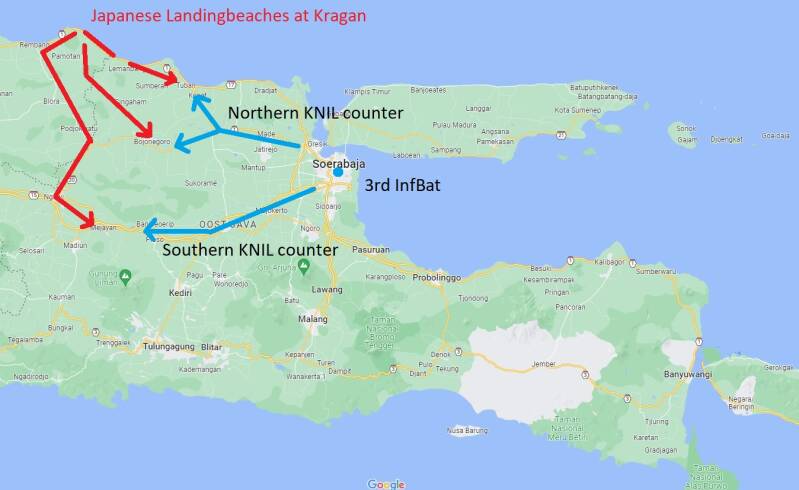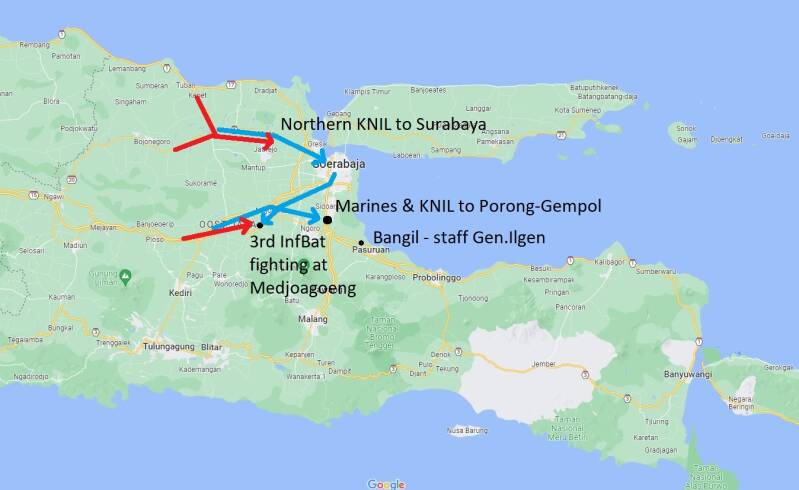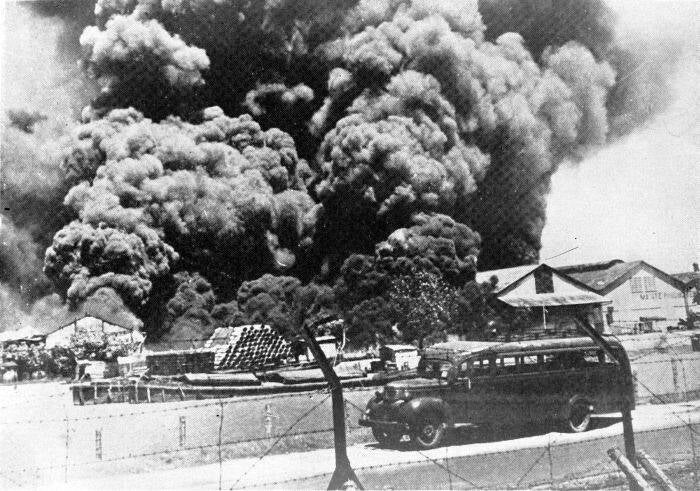Fighting the Japanese
Theo was serving as an European-Sergeant with the 6th company of the 3rd Infantry Battalion when the Japanese invaded Java. This battalion was part of the 6th Infantry Regiment/ 3rd Division commanded by General Ilgen. Its area of operations was East-Java: covering the important city of Surabaya.
In the latest photographs of Theo before the Japanese invasion he wears 'flaming grenade' insignia's on collar and shoulder. These indicate service with the heavy weapons company of the Battalion. This company had a total of 12 6,5mm machine guns (Schwarzlose M08), a section of 3 anti-tank 20mm rifles and a platoon of 6 80mm mortars. As a Sergeant he would have commanded a section of his own.
A late photograph of Theo and his section just before the Japanese invasion. Most likely while serving with the 6th company 3rd Infantry Battalion. He is sitting on the foreground most to the right - smoking a cigarette and laughing. He feels definitely more comfortable than in earlier photographs. Remarkable about this photograph is this being an European/ Dutch section. All are Indo-European and to the right in the background can be seen at least 3 Dutch soldiers - some others might be completely Dutch also.
The battle for Surabaya
The main target for the Japanese invasion forces on Eastern Java was the large marine base city of Surabaya. All units fighting in this battle as well as the Japanese invasion forces are very well described in the book 'De Japanse Aanval op Java' by by J.J.Nortier P.Kuijt and P.M.H.Groen. Order of Battles and in depth stories of unit fighting battles are very well covered. I would recommend reading this book for more stories.
Right now I will only explain Theo's unit: the 3rd Infantry Battalion. The flag of this battalion was one of only 3 battalions ever adorned with the Militaire Willems Orde (M.W.O.) obtained for performance during the KNIL Atjeh war of 1877.
Before combat erupted it was decided that the marine base of Surabaya should be defended at all costs. The 3rd Infantry Battalion was chosen for this purpose. Its units were scattered all over Surabaya on defensive positions to fight any landing Japanese paratroopers - which were thought to be used to occupy Surabaya. Minahasa and Palembang were attacked this way by the Japanese. The staff of the 3rd Division, together with general Ilgen himself, would also stay in Surabaya under protection of the 3rd Infantry Battalion.
On the first of March the Japanese landed at Kragan - 134km West of Surabaya. Large Japanese troop concentrations started moving to the South and East. KNIL units were counterattacking (by a Northern and Southern axis) but these were futile attempts. The Japanese had superior combat proven units in larger quantities with back up of tanks and aircraft. Besides this the Japanese would pincer move against Surabaya if they could not be stopped.
This made general Ilgen decide to destroy all important installations of Surabaya: the marine base itself, ships, an ammunition factory and the oil refinery on the Southside of the city. It would take several days to do so. This way the 3rd Infantry Battalion could also be freed to support their colleagues.

On the 6th of March the destruction of Surabaya was complete. The staff retreated to Bangil in the South-East. KNIL forces were continuously fighting in the South and North and had no chance to disengage. Units West of Surabaya, including an American US Army artillery unit, had to retreat to Surabaya itself. Dutch Marines were heavy engaged in the South-West together with other KNIL units.
The 3rd Infantry Battalion would advance towards the Marine battalion in order for them to retreat. The 3rd took positions around the town of Modjoagung and came under attack of Japanese tanks and mechanized infantry. After they received the message that the Marines and all other KNIL units had retreated the 3rd left their positions to link up with the main force at Porong-Gempol.

At this point the staff and general Ilgen were already considering the battle to be lost. Plans were made to use their units in a guerilla warfare. Which would be highly impractical taking in mind the needed food and logistics support.
Heavy combat erupted around Porong-Gempol. The Japanese used many tanks and air support. KNIL units managed to destroy 3 tanks with anti-tank rifles, but many units got annihilated. Civilian refugees out of Surabaya meanwhile also blocked many roads. Orders from the staff were contradicting each other and many units did not know which staff they belonged to. Chaos was complete.
The 3rd Infantry Battalion meanwhile was ordered to retreat all the way to Bangil - were general Ilgen and his staff recided. Units fighting in Porong-Gempol and Surabaya had to stand their ground. The 3rd was needed to engage into guerilla warfare. The Japanese totally ran over Porong-Gempol and they passed the defeated units towards the North: Surabaya. This meant the surviving troops of the Marines and others could also retreat to Bangil.
The troops in Surabaya took defensive lines, three batteries of US artillery took firing positions. Japanese tanks entered the city from the South (Porong-Gempol) and some were immediately taken out. Heavy combat followed with the superior Japanese forces. Some KNIL units mamaged to retreat over water towards Madoera. Surabaya fell 1 day later.
The 3rd was positioned in the Djember area - the region appointed by general Ilgen for the 3rd to commence guerilla warfare. It never came to this - the KNIL signed a general capitulation on the 8th of March.

Theo was made Prisoner of War in the town of Djember, 150 kilometers to the Southeast of Surabaya. He had followed the entire ordeal described on this page with the 3rd Infantry Battalion as heavy weapons section leader. He must have taken part in the destruction of important structures of Surabaya. He would have marched many exhausting miles and was part of the covering retreat of the Marines unit in the South - being bombed and strafed by Japanese aircraft, tanks and mortars. His unit was many times around general Ilgen personally, and Theo must have marched again a long way towards Djember. He was prepared for guerilla warfare, before being forced to surrender.
Japanese war crimes during combat
A topic never mentioned in contemporary history. Very important and relevant for the post-war era 1946-1950. People mostly know about how bad the Dutch/ KNIL Prisoners of War suffered in the Japanese POW-camps. Almost no one knows about the savage battles the Japanese waged during the first week of March 1942. I do not like to give examples of brutality but this time it is out of necessity for the complete story.
The Japanese did not care about human lifes. Their bushido society made it an honor to die in battle, a disgrace to lose and survive a battle. This made it easy for them not to take prisoners - just because they didn't want to at the moment, or because this would slow their advance. Their sadism is very well known. And they themselves would rather die than surrender.
On the airfield of Kalidjati the RAF personnel were taken by surprise. A large number was executed to spare time - about 60 were beheaded, gunned down or killed with bayonets. The same goes for an artillery battery near Lembang - possibly slowing the Japanese advance all 72 soldiers were tied together in groups of three, gunned down and killed with bayonets. Some had their eyes cut out or heads hewn off. Two KNIL soldiers witnessed the entire scene. When the military hospital at Subang was captured 20 wounded British soldiers were executed in their beds. Other large numbers of KNIL and Dutch Marines were all executed in the same manner.
Not just soldiers were murdered this way. Japanese soldiers killed and beheaded many mayors, city council members and other people. A group of 12 Dutch women were raped by a Japanese unit. When these women got free they told the story to a Japanese commander, which made its soldiers rape these women again in front of his eyes. Women were known to be raped in hospitals. A father and mother had to watch their young children being raped - in this case the parents committed suicide. Many official reports exist of all these brutalities.
Some Australian POW's which had engaged in guerilla warfare after March 1942 were all caught. In June 1942 a group of 150 were tied in pairs in bamboo baskets and put on a ship. Out on sea all were cast into the water and drowned. In the harbors of Cheribon and Tegal similar executions took place. Total numbers of executed soldiers were never established.






